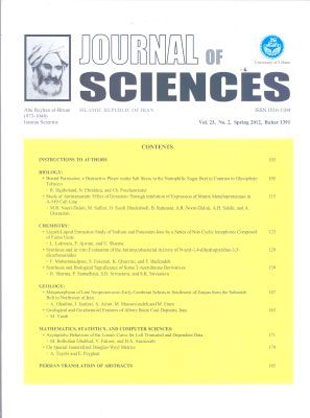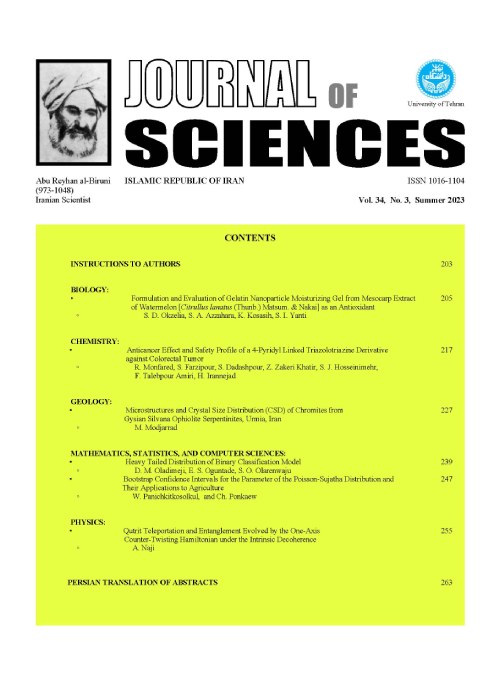فهرست مطالب

Journal of Sciences, Islamic Republic of Iran
Volume:25 Issue: 1, Winter 2014
- تاریخ انتشار: 1393/04/01
- تعداد عناوین: 9
-
-
تحول پترولوژیکی گوشته ی بالایی در زیربخش جنوبی زون سنندج - سیرجان: شاهدی از توده ی پریدوتیتی کوه شاه، جنوب شرق ایرانصفحات 35-49
-
Pages 5-12The main objective of this study was to purify and characterize an esterase from Shewanella sp F88. The enzyme was purified 41-fold and an overall yield of 21 %, using a two-step procedure, including ammonium sulfate precipitation and Q-sepharore chromatography. Molecular weight of the enzyme was 62.3 kDa according to SDS-PAGE data. The enzyme showed an optimum activity at pH 6.5 and 58 ˚C. Evolution of substrate specificity demonstrated that this thermostable enzyme had the highest activity towards para-nitrophenol acetate (pNPA, C2). Michaelis-Menten constant (Km) and maximum velocity (Vmax) of pNPA-hydrolyzing reaction were 12.6 mM and 550 U.mg-1, respectively. Enzyme activity was declined in the presence of metal ions (2 and 5 mM), including Fe2+, Ca2+, Cu2+, Zn2+, Mg2+ and Mn2+. The half-lives of purified esterase was 70 and 31 min at 60 °C and 80 °C, respectively. In conclusion, the enzyme is a novel thermostable lipolytic enzyme characterized from Shewanella species.Keywords: Esterase, Thermostable, Lipolytic enzyme, Characterization, Shewanella
-
Pages 13-17RNA extraction is a prerequisite technique for gene expression studies, analyzing the etiology and disease progression, treatment effects, as well as designing the diagnostic methods. Although many RNA extraction kits have been commercialized, but these kits are expensive and are not accessible in some countries. Many studies have shown that TRIzol is an applicable material for the RNA extraction from various biological samples. In this study, evaluation of the initial TRIzol volume and -20˚C temperature on the purity and solubility of RNA, which followed by measurement of IL-1B expression shows that TRIzol based RNA extraction is a “reliable” method for gene expression studies.Keywords: RNA, TRIzol volume, Purity, Gene expression, IL, 1B
-
Pages 19-26E-cadherin is among tumor suppressor genes which mostly subjects to the down-regulation in squamous cell carcinoma of esophagus (SCCE). The gene is tightly associated with the tumor invasion and metastasis in multiple human cancers, especially SCCE. CpG islands’ methylation in the promoter region of E-cadherin is among the mechanisms that have been suggested for the E-cadherin silencing, however, little is known regarding (SCCE) in the high risk region of the world. To establish a correlation between E-Cadherin promoter methylation with the pathological features of SCCE, as well as history, and demographic features we undertook the present investigation. Following to the surgical resection tissue samples of the 44 patients with SCCE was used for E-cadherin promoter methylation examination. Analysis was done using methylation specific polymerase chain reaction (MS-PCR). Furthermore, for evaluating E-daherin expression levels, reverse transcription PCR (RT-PCR) was applied.Results have indicated that twenty four out of the forty four tumor DNA samples (54.5%) were aberrantly methylated. In contrast, all normal tissues were found to be unmethylated. In addition a significant association was found between methylation status of E-Cadherin promoter with type I and II of the tumor differentiation (p=0.024), stages T2 and T3 of tumors (p= 0.026), as well as lymph node invasion (p= 0.004). E-cadherin tumor suppressor gene subjects to epigenetic silencing through aberrant promoter CpG islands methylation; a mechanism which is most commonly contributed with the other important tumor suppressor genes in the SCCE carcinogenesis in the world’s highest risk region for SCCE.Keywords: E, Cadherin, DNA methylation, SCCE (Squamous Cell Carcinoma of the Esophagus)
-
Pages 27-33In this work, we report a new well dispersed molybdenum complex attached through the mediation of aminopropylsilyl groups on the surface of multi-walled carbon nanotubes (MWCNTs). The prepared hybrid nanomaterial was characterized with different physicochemical methods such as Fourier transform infrared and atomic absorption spectroscopies, transmission electron microscopy, energy-dispersive X-ray and nitrogen adsorption-desorption analyses. Nitrogen adsorption-desorption analysis revealed that the textural characteristics of the support were preserved during the grafting experiments despite sequential reduction in surface area. Elemental analysis showed the presence of 0.1 mmol molybdenum per gram of the catalyst. The prepared hybrid nanomaterial showed good performance and stability in the catalytic epoxidation of olefins under mild reaction conditions.Keywords: Carbon nanotube, Hybrid nanomaterial, Molybdenum, Epoxidation
-
Petrological Evolution of the Upper Mantle Beneath the Southern Sanandaj-Sirjan Zone: Evidence from Kuhshah Peridotite Massif, Southeast IranPages 35-49The Kuhshah ultramafic complex is located in the south-east of Sanandaj-Sirjan metamorphic zone, near the probable remnants of Neotethys plate in Iran. It consists of highly depleted harzburgites, dunites, chromitite bands and altered gabbros. The ultramafic parts have been intruded by numerous clinopyroxenite dykes and veins. In the harzburgites, there are different generations of olivine, orthopyroxene and spinel. The chemical composition of the first generation minerals indicates that the harzburgites are depleted in incompatible elements, but the other generations show melt/rock interaction features which can be found in a suprasubduction zone setting. During subduction of the Neotethys plate beneath the Sanandaj-Sirjan zone, a back arc basin developed between the Sanandaj-Sirjan arc and the central Iranian microcontinent. Whole rock and mineral chemistry, specially, cromespinels, show that the harzburgites formed underneath this basin. After depletion, ascending melts with boninitic compositions reacted with these peridotites to form dunites and chromitite bands. The updoming and decompression of the mantle in the next stage, led to remelting at deeper levels and development of clinopyroxenite parental melts which intruded into the uppermost mantle. Then, the new basin closed and the Kuhshah peridotites were emplaced in present position.Keywords: Iran, Melt, peridotite reaction, Suprasubduction zone setting, Clinopyroxenite
-
Pages 51-55Let S be a locally compact foundation semigroup with identity and be its semigroup algebra. Let X be a weak*-closed left translation invariant subspace of In this paper, we prove that X is invariantly complemented in if and only if the left ideal of has a bounded approximate identity. We also prove that a foundation semigroup with identity S is left amenable if and only if every complemented weak*-closed left translation invariant subspace of is invariantly complemented in.Keywords: Complemented subspace, Foundation semigroup, Semigroup algebras
-
Pages 57-67
Kernel density estimators are the basic tools for density estimation in non-parametric statistics. The k-nearest neighbor kernel estimators represent a special form of kernel density estimators, in which the bandwidth is varied depending on the location of the sample points. In this paper, we initially introduce the k-nearest neighbor kernel density estimator in the random left-truncation model, and then prove some of its asymptotic behaviors, such as strong uniform consistency and asymptotic normality. In particular, we show that the proposed estimator has truncation-free variance. Simulations are presented to illustrate the results and show how the estimator behaves for finite samples. Moreover, the proposed estimator is used to estimate the density function of a real data set.
Keywords: Asymptotic normality, Left, truncation, Nearest neighbor, Strong consistency -
Pages 69-74
In this research the exclusive decay of is calculated by QCD factorization (QCDF) method and final state interaction (FSI). First, the decay is calculated via QCDF method. The result that is found by using the QCDF method is less than the experimental result. So FSI is considered to solve the decay. For this decay, via the exchange of mesons are chosen for the intermediate state. The above intermediate state is calculated by using the QCDF method. In the FSI effects, the results of our calculations depend on as the phenomenological parameter. The range of this parameter is selected from 2 to 3. It is found that if is selected, the numbers of the branching ratio are placed in the experimental range. The experimental branching ratio of decay is 4.9 and our results calculated by QCDF and FSI are 0.5 and 3.9 respectively.
Keywords: B meson, QCD factorization, Final state interaction, Intermediate state, Branching ratio -
Pages 75-84Recent experiments on the spherical tokamak have discovered the conditions to create a powerful plasma and ensure easy shaping and amplification of stability, high bootstrap current and confinement energy. The spherical tours (ST) fusion energy development path is complementary to the tokamak burning plasma experiment such as NSTX and higher toroidal beta regimes and improves the design of a power plant. To support the ST development path, one option of a Next Step Spherical Torus (NSST) device has been examined. NSST is a performance extension stage ST with a plasma current of 5-10 MA, R=1.5m, Bt<2.7T with flexible physics. The baseline heating and current device system for NSST is the 30MW NBI system and a 10 MW of ion cyclotron range of frequency (ICRF) and high harmonic fast wave (HHFW) system. In this work, we investigated lower hybrid wave interaction in the NSST reactor and found an optimal lower hybrid wave power and frequency for it. Finally, we compared the lower optimal hybrid waves and NSST spherical tokamak with HT-7 tokamak. Our results indicated that the use of lower hybrid waves in improved spherical tokamak NSST, as compared to the HT-7, was much better and more efficient.Keywords: Lower Hybrid Waves, Tokamak, Current Drive, Fokker, Planck Equation


